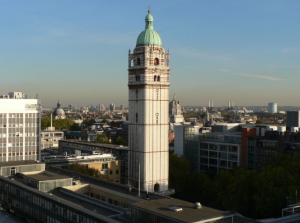As we become more concerned about rising CO2 levels in the atmosphere, people are beginning to think about ways of monitoring emission rates. In this pilot study, we investigated the potential for monitoring London’s CO2 using mixing ratio measurements in the city centre.
In order to obtain measurements of CO2 that are representative of a wide area, you need to measure at the top of a tower. At the centre of the Imperial College campus, the 80m Queen’s Tower was an excellent location for CO2 monitoring (and, since there isn’t a lift, provided some much-needed exercise for an out-of-shape atmospheric scientist).

We made one year of CO2 measurements during 2007 and 2008, and compared them to observations taken outside of London, made by Rebecca Fisher, Dave Lowry and Euan Nisbet at Royal Holloway University of London.
There were several surprising aspects to this work. We found that, generally speaking, the CO2 levels at 80m in London were not much higher than those outside, and were often significantly lower. This is partly due to the differences in sampling heights. The site outside London samples just above roof level, and is therefore likely to be more strongly influenced by emissions from the local biosphere than the site in the city. This potential influence of natural emissions close to the ‘background’ site makes it difficult to determine London’s CO2 emissions by comparing the two measurements. However, we found that it may be possible to determine emissions during the winter, when natural emissions are very small.
